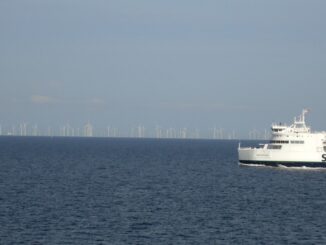
ENB Pub Note: This is the 4th article in a series with George McMillian, CEO of McMillian and Associates. The other articles and the first podcast are listed below. Buckle up, get your popcorn, and flight suit for some eye-opening conversations. Please follow George on his LinkedIn HERE.
UPDATE: All 5 of George’s Articles are on his landing page HERE: https://energynewsbeat.co/george-mcmillian/
Introduction—Cold War History of Soviet Oil and Natural Gas Pipelines
The indication that Russian oil and especially natural gas shipped by pipeline is the biggest threat to geopolitical realignment can be seen by the reaction of the Unites States as Russia began developing its oil and Gas fields in the Caspian, Ural and Arctic regions in the 1950s and then began constructing pipelines to the Warsaw Pact countries in Eastern and Central Europe.
As anticipated, the logical extension of the pipelines moving Westward would not be routed through the Warsaw Pact countries but through neutral Austria into Southern Germany from the Southern branch of the Bruzhba Pipeline and from Poland to East Germany and on to West Germany from the Northern branch of the Bruzhba pipeline.
Following Mahan’s differentiation of “production” and “wealth,” petroleum production does not become wealth until it is traded for goods that a country wants but does not produce. In this case, the Soviet Union wanted convertible Western currencies so they could buy products and reverse-engineer them.
“Russia Will Freeze and Invade Europe”
The West always put forth the narrative that the Soviet Union could blackmail Western Europe by shutting off the pipelines during the Winter. But that threat diminishes when one considers that if the Western countries maintain the minimum three-month strategic petroleum reserve as they are supposed to, then they would have plenty of time to buy energy supplies elsewhere, albeit it at a higher price. So why are they discouraged from buying as much oil and natural gas as they can at a lower price?
The reason why the US is so strongly opposed to its Western Europe allies buying cheaper Russian oil and natural gas via pipeline lies in the logic of the “Instruments of National Power,” that is, the way a nation’s power is measured. The two primary measures are PMESII and DIME analysis: Political, Military, Economic, Social, Infrastructural, and Informational (PMESII) effectiveness of a country or the shorter Diplomatic, Infrastructural/Informational, Military and Economic (DIME) measure of effectiveness.
While the acronyms are sequenced to create the best pneumonic device for the sake of memory, the behavioral reality is that humans always employ “armed guards” to protect their investments. They know from Solow-Swan models that infrastructural investment and integration promote economic integration and expansion which always culminates in enhanced diplomatic and military armed alliances.
After 1973, when the US and the Kingdom of Saudi Arabia (KSA) left the Bretton Woods gold standard and shifted to the floating petrodollar system after the Yom Kippur War, an additional concern arose that the US wanted to maintain the petrodollar trading scheme. Since the 1973 Petrodollar was agreed to by the US and the KSA, and OPEC accepted the arrangement in 1975, the US always relied on the global petrodollar demand to finance its yearly budget deficits.
It might have taken a few decades, but since the Global War on Terror (GWOT) the US budget deficits have risen from $5 trillion to almost $34 trillion dollars. It appears that as the US national debt rises the more important the external use and demand of the US dollar externalizes inflation to the rest of the world.
The external demand of the US petrodollar is now what keeps the US from experiencing Weimar Republic-style inflation.
The Post-Reagan Budget Deficits
After the increases in national debt during the Reagan administration and the profligate spending in the post-GWOT Bush and Obama administrations, the original reason for the US to prevent its European allies from buying cheap Russian oil and natural gas shifted beyond the initial “DIME” concerns to the potentially catastrophic mass exodus of its allies from using the “petrodollar” in their energy purchases.
Since in 2023, the US has approximately $34 trillion in accumulated debt, plus three or four times that in unfunded social service mandates and future pension liabilities, the petrodollar aspect is now paramount.
As mentioned in a previous article, and as will be restated in future articles in this series, there is no way the US can (a) allow cheap oil and natural gas from Russia to be shipped to any ally in Europe or the Pacific Rim, and then (b) allow the end user to pay directly in rubles, cutting out the Wall Street middle man thereby exiting the petrodollar system and paying in other currencies.

The US—to maintain its Superpower status and avoid Weimar Republic-style inflation—must focus on preventing “a” its allies from infrastructural “DIME” integration from occurring and “b” its allies from paying in non-dollars.
The US/UK/NATO Counter Strategy of the 1990s
The US depends on maintaining Western Europe as an ally on the Atlantic side, and Japan and South Korean as allies on the Pacific side to keep the global economic and political center of gravity in Washington and London. The more one understands the “DIME” national power sequence in conjunction with the Five Power Center Doctrine of George Kennan (see John Lewis Gaddis “Strategies of Containment,” 1982) the more one will realize this necessity.
The alternatives—should the US allow Russian oil and natural gas to be delivered by pipeline to Western Europe—is that the global political center of gravity will be shared between Washington and London and Berlin and Moscow, leaving Beijing isolated in this scenario.
Foreseeably, by thwarting Russian oil and gas delivery by pipeline to Western Europe at all costs (the topic of the next two articles), and trying to isolate both Russia and China, the US has compelled Russia and China to integrate instead. In its attempt to maintain its sole Superpower status, the United States is risking its financial well-being and that of its allies. This could quite possibly chase its European and Pacific Rim allies into the safety of the Russian oil and natural gas network.
Types of Geopolitical Theory
It is important to understand the DIME analysis of national economic, diplomatic and military power relationships in the context of post-Mahan sea power versus sea power and post-Macinder sea power versus land power geostrategic theories.
In terms of Mackinder’s geopolitical theory, it is important to understand that Russia is in the “heartland” of Eurasia and is using a Haushofer “land-power” style integration of Eurasia. China is using both a land power integration of Eurasia strategy with its original Silk Road Initiative and a sea power strategy with its maritime Belt and Road Initiative.
In contrast, the US and the UK appear to be employing a Spykman-based “sea power” divide-and-conquer “balance of power” strategies to thwart the global economic and political center of gravity from shifting to a Berlin-Moscow or Moscow-Beijing combination. But by trying to maintain sole superpower status with full spectrum dominance, the Anglosphere risks the global political centers of gravity shifting to a Berlin-Moscow-Beijing alliance if the Alternative for Deutschland Party defeats Olaf Scholz in the next election cycle in Germany.
[end]
The other three articles and podcast episode in this series.
The US Cut-off their European Allies from Affordable Energy—Now What?
Russian Natural Gas and Geopolitical Realignment—a reverse domino theory
The Geopolitical Problem of the US—a German-Russo-Japanese Connection
ENB #160 What is the United States afraid of? George McMillan, CEO of McMillian Associates, stopped by the Energy News Beat podcast. – UPDATE
Follow Stuart On LinkedIn and Twitter



